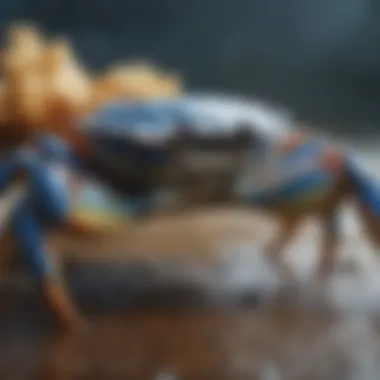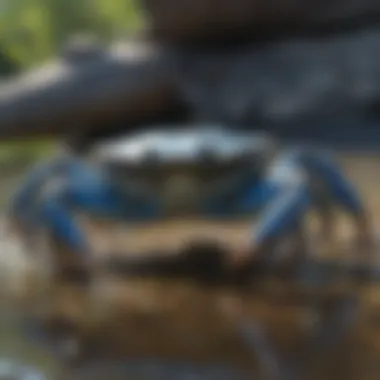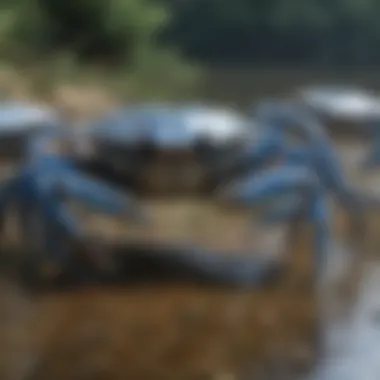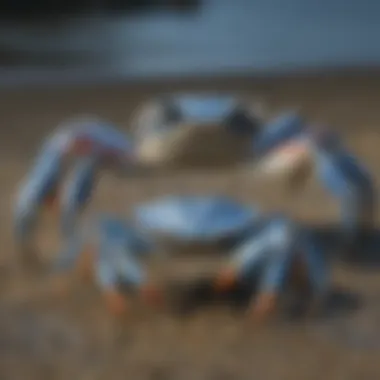Unlocking the Magic of Blue Crab Season: An In-Depth Guide for Enthusiasts


Overview of Blue Crab Season
The blue crab season is a time of great significance, offering enthusiasts and conservationists a unique insight into the world of this fascinating crustacean species. Blue crabs, known for their distinctive blue hue and delicious meat, play a crucial role in the aquatic ecosystems they inhabit. Understanding the intricacies of the blue crab season involves delving into their life cycle, habitat preferences, and the challenges they face in today's changing environment.
Life Cycle and Habits
Blue crabs undergo a complex life cycle, starting as larvae in the water column before molting into juvenile crabs. As they mature, they transition into adults and begin the process of reproduction. These crabs exhibit interesting feeding behaviors and interactions within their habitat, showcasing their adaptability to various environmental conditions. By exploring their natural behaviors, enthusiasts gain a deeper appreciation for the blue crab's role in the marine ecosystem.
Molting and Growth Stages
A critical aspect of the blue crab's life cycle is the molting process, where they shed their exoskeleton to grow larger. This vulnerable stage presents challenges for their survival, as they require sufficient food resources and shelter to support growth. Understanding the different growth stages of blue crabs provides insight into their vulnerability and the importance of conservation efforts to protect their populations from decline.
Sustainable Harvesting Practices
Sustainable harvesting of blue crabs is essential to ensure the longevity of this valuable natural resource. Conservationists and fishery managers work together to implement regulations that promote responsible harvesting techniques, such as size limits and seasonal closures. By adopting sustainable practices, communities can enjoy the economic benefits of crab fishing while preserving the ecological balance of blue crab populations.
Conservation Efforts
Efforts to conserve blue crab populations involve monitoring crab abundance, habitat effectiveness, and the impacts of environmental factors on their survival. Conservationists collaborate with scientists to study population trends and implement strategies to mitigate the threats facing blue crabs, such as habitat loss and pollution. Through research and conservation initiatives, stakeholders contribute to the sustainability of blue crab populations for future generations.
Conclusion
Exploring the blue crab season unveils a world of beauty and complexity, highlighting the importance of conservation and sustainable resource management. As enthusiasts and conservationists delve into the intricacies of blue crab habitats and behaviors, they become stewards of marine ecosystems, advocating for the preservation of this iconic species. By championing sustainable solutions and fostering awareness, individuals can make a meaningful impact on the conservation of blue crabs and the marine environments they inhabit.
Introduction to Blue Crabs
Blue crabs are a fascinating species that play a crucial role in marine ecosystems. Understanding their behavior and significance is paramount for conserving these valuable crustaceans. In this section, we will delve into the intricacies of blue crabs, exploring their characteristics and importance in the ecosystem.
An Overview of Blue Crab Species
When discussing blue crabs, we encounter two prominent species: the Atlantic Blue Crab and the Gulf Blue Crab. Each species possesses unique characteristics that contribute to their popularity and ecological impact.
The Atlantic Blue Crab
The Atlantic Blue Crab, known for its distinctive blue claws and versatile meat, is a prized choice for seafood enthusiasts. Its widespread distribution along the East Coast makes it a staple in many coastal communities' diets. Despite its popularity, concerns exist regarding its sustainability due to over-harvesting.
The Gulf Blue Crab
In the Gulf of Mexico, the Gulf Blue Crab thrives with its robust flavor and ample availability. Local fishermen heavily rely on this species for their livelihoods, showcasing its economic importance. However, careful monitoring is necessary to prevent a decline in population and preserve this valuable resource.
Distinguishing Features
One of the key distinguishing features of blue crabs is their ability to regenerate lost limbs during the molting process. This unique adaptation aids in their survival and illustrates their resilience in changing environments. Understanding these features is essential for appreciating the adaptability of blue crabs.


Importance of Blue Crabs in Ecosystems
Blue crabs hold immense significance in marine ecosystems, contributing to biodiversity and ecosystem balance. Their economic value, ecological roles, and environmental impact all underscore the importance of conserving these remarkable creatures.
Economic Significance
Commercially, blue crabs support local economies through fisheries and seafood markets. Their high demand in culinary settings drives economic activity in coastal regions, highlighting their economic significance. Sustainable practices are integral to ensuring a stable market for blue crabs.
Ecological Role
In ecosystems, blue crabs serve as keystone species, influencing the behavior of prey species and maintaining ecological equilibrium. Their predation on bivalves regulates populations and promotes species diversity, emphasizing their crucial ecological role. Conservation efforts are necessary to safeguard their contributions to marine ecosystems.
Environmental Impact
Blue crabs can also impact their surroundings through their feeding habits and interactions with other species. By understanding their environmental role, we can implement conservation strategies to mitigate adverse effects on habitats and maintain ecosystem health.
Blue Crab Life Cycle
The life cycle of a blue crab is a complex and fascinating journey that encompasses various developmental stages. From egg development to the adult stage, each phase plays a critical role in the sustainability and population dynamics of blue crab species.
Egg Development
The process of egg development in blue crabs begins with females carrying fertilized eggs beneath their abdomen. These eggs undergo multiple stages of growth, culminating in hatchlings ready to navigate their marine environment. Egg development is a vital phase in ensuring the continuity of blue crab populations.
Larval Stages
Once hatched, blue crab larvae enter the water column, undergoing molts and metamorphosis to reach juvenile stages. This period of growth and transformation is essential for developing their characteristic features and behaviors. Larval stages mark a significant transition in a blue crab's life cycle.
Molted Juveniles
As molting juveniles, blue crabs shed their exoskeletons to accommodate growth, revealing soft shells vulnerable to predation. This phase is crucial for rapid growth and maturation, preparing them for the challenges they will encounter as they transition to adulthood. Understanding the vulnerabilities of molting juveniles is essential for evaluating their survival strategies.
Adult Stage
Upon reaching adulthood, blue crabs exhibit their full-size potential and reproductive capability. Their adult stage is characterized by active foraging, mating behaviors, and contributing to the next generation of blue crab offspring. Conservation efforts aim to protect adult populations and ensure their continued presence in marine ecosystems.
Blue Crab Season Overview
In this extensive article, we will delve deep into the intricate world of the Blue Crab Season. Understanding the timing, regulations, and impact of climate change on Blue Crab Seasons is vital for enthusiasts and conservationists alike. Exploring the peak harvesting periods and conservation efforts sheds light on the delicate balance required for sustainable crabbing practices.
Timing of Blue Crab Season
Factors Influencing Seasonal Cycles


Delving into the factors influencing seasonal cycles provides a critical insight into the natural rhythms governing Blue Crab Seasons. Understanding these factors, such as water temperature and prey availability, is fundamental to predicting peak crabbing periods and managing conservation efforts effectively. By comprehending the intricacies of these cycles, stakeholders can align harvesting practices with ecological sustainability.
Peak Harvesting Periods
Unraveling the phenomenon of peak harvesting periods unveils the optimal times for crabbers to maximize their yield. Examining the environmental conditions and biological triggers that coincide with these periods enables a strategic and efficient approach to crabbing. Identifying and capitalizing on these peak periods ensures a bountiful harvest while safeguarding the long-term health of crab populations.
Regulations and Conservation Efforts
Legal Restrictions on Crabbing
Navigating the labyrinth of legal restrictions on crabbing is paramount for upholding ethical practices and preserving crab populations. By complying with size limits, seasonal closures, and catch quotas, crabbers play a crucial role in sustaining the delicate balance of marine ecosystems. These regulations serve as a protective shield, ensuring the continuity of blue crab populations for future generations.
Sustainable Harvesting Practices
Embracing sustainable harvesting practices is not merely a choice but a responsibility towards ecological conservation. By adopting methods that minimize bycatch, reduce habitat destruction, and promote selective harvesting, crabbers contribute to the resilience of blue crab populations. Implementing these practices fosters a harmonious relationship between human exploitation and environmental preservation.
Protection of Breeding Grounds
Safeguarding the breeding grounds of blue crabs is a cornerstone of conservation efforts aimed at ensuring the longevity of these iconic crustaceans. Preserving essential habitats such as marshes, estuaries, and seagrass beds is imperative for the reproductive success of blue crabs. By establishing protected areas and enforcing habitat conservation measures, stakeholders can fortify the foundation of blue crab populations.
Impact of Climate Change on Blue Crab Seasons
Shifts in Migration Patterns
Examining the shifting migration patterns of blue crabs under the influence of climate change unveils a complex interplay between environmental factors and species behavior. Understanding these patterns is crucial for anticipating future changes in crab distributions and abundance. By adapting management strategies to accommodate these shifts, stakeholders can mitigate the adverse effects of climate change on blue crab populations.
Adaptation Strategies
Developing adaptation strategies in response to climate change challenges traditional approaches to blue crab management. Implementing measures such as habitat restoration, species monitoring, and community engagement fosters resilience in the face of environmental uncertainty. By embracing adaptive practices, stakeholders can proactively address the changing dynamics of blue crab habitats and ensure the perpetuation of these invaluable species.
Harvesting and Preparation
Harvesting and preparation play a crucial role in this comprehensive guide on exploring the blue crab season. Understanding the methods of crabbing, cleaning, and cooking blue crabs is essential for enthusiasts and conservationists alike. By delving into these specific elements, readers can appreciate the intricacies of sustainable harvesting practices and their significance in maintaining ecological balance.
Methods of Crabbing
Traps and Pots
Traps and pots are fundamental to the process of crabbing, offering a passive yet effective method of harvesting blue crabs. Their key characteristic lies in their ability to lure crabs inside while preventing their escape, making them a popular choice among crabbers. The unique feature of traps and pots is their versatility, allowing crabbers to target specific crab species or sizes. However, their main disadvantage is the potential impact on non-target species and habitats, a consideration highlighted in this article.
Hand-Lining
Hand-lining involves a more hands-on approach to crabbing, utilizing a fishing line with bait to attract and hook blue crabs. The key characteristic of hand-lining is its simplicity and portability, making it a preferred choice for recreational crabbers. The unique feature of hand-lining is the direct interaction it offers with the crabs, providing a sense of connection to the harvesting process. Despite its effectiveness, hand-lining may have limitations in terms of catch volume, a factor discussed in this article.


Dredging
Dredging represents a mechanized approach to crabbing, involving the use of a dredge to scoop crabs off the seabed. The key characteristic of dredging is its efficiency in harvesting large quantities of crabs in a short time frame, making it popular among commercial crabbers. The unique feature of dredging is its potential impact on marine habitats and bottom-dwelling species, a drawback that requires careful consideration in sustainable crabbing practices.
Cleaning and Cooking Blue Crabs
Cleaning and cooking blue crabs is a culinary art that enhances the gastronomic experience of enjoying these delicious crustaceans. From mastering the art of removing the carapace to exploring various cooking techniques and popular recipes, this section offers valuable insights into preparing blue crabs for consumption. By emphasizing the importance of proper cleaning and cooking methods, readers can elevate their culinary skills while ensuring the sustainable enjoyment of blue crabs.
Removing the Carapace
Removing the carapace is a critical step in cleaning blue crabs, allowing easy access to the succulent meat within. The key characteristic of this process is its impact on the presentation and flavor of crab dishes, making it a crucial aspect of seafood preparation. The unique feature of carapace removal is the precision and skill required to extract the meat intact, enhancing the culinary experience. However, the process may be time-consuming, a consideration addressed in this article.
Cooking Techniques
Cooking techniques play a significant role in enhancing the natural flavors of blue crab meat, whether through steaming, boiling, or grilling. The key characteristic of cooking techniques is their ability to influence the texture and taste of crab dishes, offering a wide array of culinary possibilities. The unique feature of different cooking methods lies in their ability to cater to diverse culinary preferences and traditions, enriching the gastronomic diversity of blue crab cuisine. However, selecting the appropriate cooking technique may require experimentation based on personal preferences, a journey explored in this article.
Popular Recipes
Exploring popular recipes provides inspiration for culinary enthusiasts to incorporate blue crabs into their meals creatively. Whether enjoying classic crab cakes, spicy curries, or innovative fusion dishes, the possibilities are endless. The key characteristic of popular recipes is their ability to showcase the versatility of blue crab meat, appealing to a wide audience of food lovers. The unique feature of each recipe lies in its blend of flavors, textures, and culinary influences, creating a sensory experience that celebrates the essence of blue crab cuisine. While popular recipes offer convenience and culinary inspiration, customizing them to personal tastes can elevate the dining experience, a practice encouraged in this article.
Culinary Delights and Beyond
The Culinary Delights and Beyond section of this comprehensive guide on exploring the Blue Crab Season delves into the significance of blue crabs in gastronomy and beyond. Blue crabs are not only vital in ecosystems but also play a crucial role in culinary arts and cultural practices. Understanding their culinary importance enhances our appreciation for these creatures and promotes sustainable enjoyment. Exploring signature dishes, cultural significance, and other dimensions of blue crabs adds depth and dimension to this guide.
Blue Crab in Gastronomy
Signature Dishes: Unveiling the essence of signature dishes involving blue crabs widens the culinary spectrum in this article. These dishes hold a special place with their unique blend of flavors and textures. They contribute greatly to the overall discussion on blue crabs in gastronomy, showcasing the versatility and richness of this marine delicacy. The intricate process of preparing signature blue crab dishes highlights the attention to detail and culinary expertise required, making them a popular choice among enthusiasts and chefs alike.
Cultural Significance: The cultural significance of blue crabs in gastronomy adds a layer of tradition and heritage to this article. These culinary practices symbolize more than just food; they represent memories, customs, and a way of life for communities connected to the coast. Recognizing the cultural importance of blue crabs in gastronomy enriches our understanding of local traditions and fosters a sense of respect for diverse culinary heritages. Incorporating cultural elements into discussions about blue crabs enhances the narrative and resonates with readers interested in the intersection of food and culture.
Beyond the Plate
Art and Literature: The integration of blue crabs in art and literature amplifies the discussion on these crustaceans beyond their gastronomic value. Artistic expressions and literary pieces inspired by blue crabs offer a unique perspective on these creatures, showcasing their beauty and significance in creative endeavors. Exploring how blue crabs influence art and literature deepens the narrative of this guide, appealing to readers interested in the arts and humanities.
Blue Crab Festivals: Blue Crab festivals emerge as vibrant celebrations that highlight the cultural significance and culinary delights associated with these creatures. These festivals bring communities together to showcase local cuisines, crafts, and performances centered around blue crabs. Participation in blue crab festivals allows individuals to immerse themselves in the culture surrounding these marine creatures, fostering a sense of community and appreciation for coastal traditions.
Conservation Initiatives: The inclusion of conservation initiatives in discussions about blue crabs emphasizes the importance of preserving and safeguarding these species. Conservation efforts play a crucial role in maintaining the delicate balance of ecosystems and ensuring the sustainability of blue crab populations. By promoting awareness of conservation initiatives, this article advocates for environmental stewardship and encourages readers to engage in efforts aimed at protecting marine life for future generations.
Conclusion
Appreciating the Blue Crab Season
Sustainable Enjoyment
Discussing sustainable enjoyment in the realm of the blue crab season is paramount. It entails not only relishing the delectable taste of blue crabs but also ensuring that such joy is derived without harming the ecosystem. Sustainable enjoyment focuses on partaking in crab-related activities in a responsible manner, considering the longevity of blue crab populations and the health of their habitats. By opting for sustainable practices such as limiting overfishing and supporting conservation efforts, enthusiasts can savor blue crabs while contributing to their preservation. This aspect of sustainable enjoyment not only benefits the environment but also enhances the overall experience of engaging with blue crabs, aligning passion with responsibility.
Environmental Stewardship
Environmental stewardship plays a crucial role in fostering a harmonious relationship between human activities and the natural environment during the blue crab season. It involves conscientious decision-making aimed at conserving the delicate balance of ecosystems where blue crabs thrive. By promoting sustainable harvesting methods, advocating for marine protection zones, and engaging in awareness programs, environmental stewardship ensures the long-term sustainability of blue crab populations and their habitats. The key characteristic of environmental stewardship lies in its ability to instill a sense of accountability among individuals, encouraging them to act as custodians of the environment. Embracing environmental stewardship in the context of the blue crab season not only safeguards the species but also enriches the overall conservation efforts, paving the way for a brighter future for blue crabs and their ecosystems.



